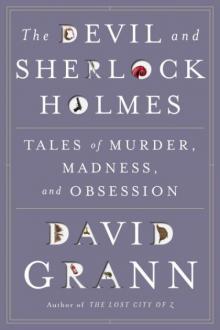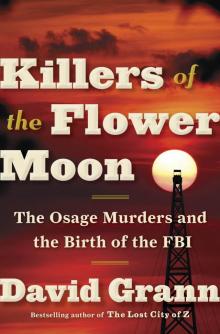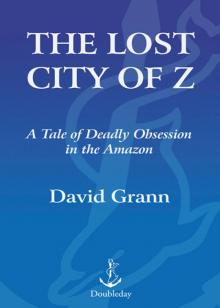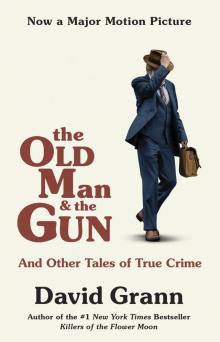- Home
- David Grann
Killers of the Flower Moon Page 2
Killers of the Flower Moon Read online
Page 2
Before the shower, the servant said, she’d stopped by Anna’s house to close any open windows. “I thought the rain would blow in,” she explained. But the door was locked, and there was no sign of Anna. She was gone.
News of her absence coursed through the boomtowns, traveling from porch to porch, from store to store. Fueling the unease were reports that another Osage, Charles Whitehorn, had vanished a week before Anna had. Genial and witty, the thirty-year-old Whitehorn was married to a woman who was part white, part Cheyenne. A local newspaper noted that he was “popular among both the whites and the members of his own tribe.” On May 14, he’d left his home, in the southwestern part of the reservation, for Pawhuska. He never returned.
Still, there was reason for Mollie not to panic. It was conceivable that Anna had slipped out after Bryan had dropped her off and headed to Oklahoma City or across the border to incandescent Kansas City. Perhaps she was dancing in one of those jazz clubs she liked to visit, oblivious of the chaos she’d left trailing in her wake. And even if Anna had run into trouble, she knew how to protect herself: she often carried a small pistol in her alligator purse. She’ll be back home soon, Ernest reassured Mollie.
A week after Anna disappeared, an oil worker was on a hill a mile north of downtown Pawhuska when he noticed something poking out of the brush near the base of a derrick. The worker came closer. It was a rotting corpse; between the eyes were two bullet holes. The victim had been shot, execution-style.
It was hot and wet and loud on the hillside. Drills shook the earth as they bore through the limestone sediment; derricks swung their large clawing arms back and forth. Other people gathered around the body, which was so badly decomposed that it was impossible to identify. One of the pockets held a letter. Someone pulled it out, straightening the paper, and read it. The letter was addressed to Charles Whitehorn, and that’s how they first knew it was him.
Around the same time, a man was squirrel hunting by Three Mile Creek, near Fairfax, with his teenage son and a friend. While the two men were getting a drink of water from a creek, the boy spotted a squirrel and pulled the trigger. There was a burst of heat and light, and the boy watched as the squirrel was hit and began to tumble lifelessly over the edge of a ravine. He chased after it, making his way down a steep wooded slope and into a gulch where the air was thicker and where he could hear the murmuring of the creek. He found the squirrel and picked it up. Then he screamed, “Oh Papa!” By the time his father reached him, the boy had crawled onto a rock. He gestured toward the mossy edge of the creek and said, “A dead person.”
There was the bloated and decomposing body of what appeared to be an American Indian woman: she was on her back, with her hair twisted in the mud and her vacant eyes facing the sky. Worms were eating at the corpse.
The men and the boy hurried out of the ravine and raced on their horse-drawn wagon through the prairie, dust swirling around them. When they reached Fairfax’s main street, they couldn’t find any lawmen, so they stopped at the Big Hill Trading Company, a large general store that had an undertaking business as well. They told the proprietor, Scott Mathis, what had happened, and he alerted his undertaker, who went with several men to the creek. There they rolled the body onto a wagon seat and, with a rope, dragged it to the top of the ravine, then laid it inside a wooden box, in the shade of a blackjack tree. When the undertaker covered the bloated corpse with salt and ice, it began to shrink as if the last bit of life were leaking out. The undertaker tried to determine if the woman was Anna Brown, whom he’d known. “The body was decomposed and swollen almost to the point of bursting and very malodorous,” he later recalled, adding, “It was as black as a nigger.”
He and the other men couldn’t make an identification. But Mathis, who managed Anna’s financial affairs, contacted Mollie, and she led a grim procession toward the creek that included Ernest, Bryan, Mollie’s sister Rita, and Rita’s husband, Bill Smith. Many who knew Anna followed them, along with the morbidly curious. Kelsie Morrison, one of the county’s most notorious bootleggers and dope peddlers, came with his Osage wife.
Mollie and Rita arrived and stepped close to the body. The stench was overwhelming. Vultures circled obscenely in the sky. It was hard for Mollie and Rita to discern if the face was Anna’s—there was virtually nothing left of it—but they recognized her Indian blanket and the clothes that Mollie had washed for her. Then Rita’s husband, Bill, took a stick and pried open her mouth, and they could see Anna’s gold fillings. “That is sure enough Anna,” Bill said.
Rita began to weep, and her husband led her away. Eventually, Mollie mouthed the word “yes”—it was Anna. Mollie was the one in the family who always maintained her composure, and she now retreated from the creek with Ernest, leaving behind the first hint of the darkness that threatened to destroy not only her family but her tribe.
2 AN ACT OF GOD OR MAN?
A coroner’s inquest, composed of jurors and led by a justice of the peace, was hastily convened at the ravine. Inquests were a remnant of a time when ordinary citizens largely assumed the burden of investigating crimes and maintaining order. For years after the American Revolution, the public opposed the creation of police departments, fearing that they would become forces of repression. Instead, citizens responded to a hue and cry by chasing after suspects. Benjamin N. Cardozo, the future Supreme Court justice, once noted that these pursuits were made “not faintly and with lagging steps, but honestly and bravely and with whatever implements and facilities are convenient and at hand.”
Only in the mid-nineteenth century, after the growth of industrial cities and a rash of urban riots—after dread of the so-called dangerous classes surpassed dread of the state—did police departments emerge in the United States. By the time of Anna’s death, the informal system of citizen policing had been displaced, but vestiges of it remained, especially in places that still seemed to exist on the periphery of geography and history.
The justice of the peace selected the jurors from among the white men at the ravine, including Mathis. They were charged with determining whether Anna had died by an act of God or man, and if it had been a felony, then they were tasked with trying to identify the principals and the accessories to the crime. Two doctors, the brothers James and David Shoun, who cared for Mollie’s family, had been summoned to perform an autopsy. Leaning over the body, with members of the inquest huddled around them, they began to diagnose the dead.
Each corpse tells its own story. A fractured hyoid—a bone in the neck that supports the tongue—can indicate that a person has been strangled. Marks on the neck can further reveal whether the killer used his bare hands or a cord. Even a victim’s torn fingernail can speak of a fateful struggle. An influential nineteenth-century manual on medical jurisprudence cited the saying “A medical man, when he sees a dead body, should notice everything.”
The Shoun brothers set up a plank as a makeshift table. From a medical bag, they removed a few primitive instruments, including a saw. The heat slithered into the shade. Flies swarmed. The doctors examined the clothes Anna wore—her bloomers, her skirt—searching for unusual tears or stains. Finding nothing, they tried to determine the time of death. This is more difficult than generally presumed, particularly after a person has been dead for several days. In the nineteenth century, scientists believed that they had solved the riddle by studying the phases a body passes through after death: the stiffening of the limbs (rigor mortis), the corpse’s changing temperature (algor mortis), and the discoloring of the skin from stagnant blood (livor mortis). But pathologists soon realized that too many variables—from the humidity in the air to the type of clothing on the corpse—affect the rate of decomposition to allow a precise calculation. Still, a rough estimate of the time of death can be made, and the Shouns determined that Anna had been deceased between five and seven days.
The ravine where Anna Brown’s body was found Credit 5
The doctors shifted Anna’s head slightly in the wooden box. Part of her scalp slipped off, revea
ling a perfectly round hole in the back of her skull. “She’s been shot!” one of the Shouns exclaimed.
There was a stirring among the men. Looking closer, they saw that the hole’s circumference was barely that of a pencil. Mathis thought that a .32-caliber bullet had caused the wound. As the men traced the path of the bullet—it had entered just below the crown, on a downward trajectory—there was no longer any doubt: Anna’s death had been cold-blooded murder.
Lawmen were then still largely amateurs. They rarely attended training academies or steeped themselves in the emerging scientific methods of detection, such as the analysis of fingerprints and blood patterns. Frontier lawmen, in particular, were primarily gunfighters and trackers; they were expected to deter crimes and to apprehend a known gunman alive if possible, dead if necessary. “An officer was then literally the law and nothing but his judgment and his trigger finger stood between him and extermination,” the Tulsa Daily World said in 1928, after the death of a veteran lawman who’d worked in the Osage territory. “It was often a case of a lone man against a pack of cunning devils.” Because these enforcers received pitiful salaries and were prized for being quick draws, it’s not surprising that the boundary between good lawmen and bad lawmen was porous. The leader of the Dalton Gang, an infamous nineteenth-century band of outlaws, once served as the main lawman on the Osage reservation.
At the time of Anna’s murder, the Osage County sheriff, who carried the bulk of responsibility for maintaining law and order in the area, was a fifty-eight-year-old, three-hundred-pound frontiersman named Harve M. Freas. A 1916 book about the history of Oklahoma described Freas as a “terror to evil doers.” But there were also murmurings that he was cozy with criminal elements—that he gave free rein to gamblers and to bootleggers like Kelsie Morrison and Henry Grammer, a rodeo champion who had once served time for murder and who controlled the local distribution of moonshine. One of Grammer’s workers later admitted to authorities, “I had the assurance that if I was ever arrested…I would be turned out in five minutes.” A group of citizens from Osage County had previously issued a resolution—on behalf of “religion, law enforcement, home decency and morality”—stating, “That the people who believe a sworn officer of the Law should enforce the Law are hereby urged to see or write Sheriff Freas, at once, and urge upon him to do his sworn duty.”
When Sheriff Freas was informed about Anna’s murder, he was already preoccupied with Whitehorn’s slaying, and he initially sent one of his deputies to collect evidence. Fairfax had a town marshal, the equivalent of a police chief, who joined the deputy at the ravine while the Shoun brothers were still conducting the autopsy. To identify the murder weapon, the lawmen needed to extract the bullet that was apparently lodged in Anna’s skull. Using their saw, the Shouns cut through her cranium, then carefully lifted her brain and placed it on the plank. “The brains were in such a bad shape,” David Shoun recalled. “You couldn’t trace the bullet at all.” He picked up a stick and probed the brain. The bullet, he announced, was nowhere to be found.
The lawmen went down to the creek, scouring the murder scene. By a rock on the bank were smears of blood, marking where Anna’s body had lain. There was no sign of the bullet, but one of the lawmen noticed a bottle on the ground, which was partially filled with a clear liquid. It smelled like moonshine. The lawmen surmised that Anna had been sitting on the rock, drinking, when someone came up behind her and shot her at close range, causing her to topple over.
The marshal spotted two distinct sets of car tracks running between the road and the gulch. He called out, and the deputy sheriff and the inquest members rushed over. It looked as though both cars had come into the gulch from the southeast, then circled back.
No other evidence was collected. The lawmen were untrained in forensic methods and didn’t make a cast impression of the tire marks, or dust the bottle for fingerprints, or check Anna’s body for gunpowder residue. They didn’t even photograph the crime scene, which, in any case, had already been contaminated by the many observers.
Someone, though, retrieved one of Anna’s earrings from her body and brought it to Mollie’s mother, who was too ill to venture to the creek. Lizzie instantly recognized it. Anna was dead. As with all Osage, the birth of her children had been the greatest blessing of Wah’Kon-Tah, the mysterious life force that pervades the sun and the moon and the earth and the stars; the force around which the Osage had structured their lives for centuries, hoping to bring some order out of the chaos and confusion on earth; the force that was there but not there—invisible, remote, giving, awesome, unanswering. Many Osage had given up their traditional beliefs, but Lizzie had held on to them. (A U.S. government official had once complained that women like Lizzie “keep up the old superstitions and laugh down modern ideas and customs.”) Now someone, something, had taken Lizzie’s oldest and most favored daughter before her allotted time—a sign, perhaps, that Wah’Kon-Tah had withdrawn his blessings and that the world was slipping into even greater chaos. Lizzie’s health grew even worse, as if grief were its own disease.
Mollie (right) with her sister Anna and their mother, Lizzie Credit 6
Mollie relied on Ernest for support. A lawyer who knew them both noted that his “devotion to his Indian wife and his children is unusual…and striking.” He comforted Mollie as she threw herself into organizing Anna’s funeral. There were flowers to be purchased, along with a white metal coffin and a marble tombstone. Undertakers charged the Osage exorbitant rates for a funeral, trying to gouge them, and this was no exception. The undertaker demanded $1,450 for the casket, $100 for preparing and embalming the body, and $25 for the rental of a hearse. By the time he was done tallying the accessories, including gloves for the grave digger, the total cost was astronomical. As a lawyer in town said, “It was getting so that you could not bury an Osage Indian at a cost of under $6,000”—a sum that, adjusted for inflation, is the equivalent of nearly $80,000 today.
The funeral was arranged to reflect the family’s Osage and Catholic traditions. Mollie, who had gone to a missionary school in Pawhuska, regularly attended Mass. She liked to sit in the pews as the Sunday morning light came through the windows and listen to the sermon of the priest. She also liked to socialize among friends, and there was plenty of that on Sundays.
The funeral service for Anna began at the church. William Hale, Ernest’s uncle, was very close to Anna and Mollie’s family, and he served as one of the pallbearers. The priest chanted the rhythmic thirteenth-century hymn “Dies Irae,” which culminates with a supplication:
SWEET JESUS LORD MOST BLEST,
GRANT THE DEAD ETERNAL REST.
After the priest sprinkled holy water over Anna’s casket, Mollie guided her family and the other mourners to a cemetery in Gray Horse, a quiet, isolated spot overlooking the endless prairie. Mollie’s father and her sister Minnie were buried there in adjoining plots, and beside them was a freshly dug pit, damp and dark, awaiting Anna’s casket, which had been transported to the edge of the grave site. Her tombstone bore the inscription “Meet Me in Heaven.” Ordinarily at the cemetery the lid of a coffin was lifted a final time before interment, allowing loved ones to say good-bye, but the condition of Anna’s body made that impossible. More troubling, her face couldn’t be painted to signal her tribe and clan—a tradition at Osage funerals. If this ritual of ornamentation didn’t occur, Mollie feared Anna’s spirit might be lost. Still, Mollie and her family placed enough food in the casket for Anna’s three-day journey to what the Osage refer to as the Happy Hunting Ground.
The older mourners, like Mollie’s mother, began to recite Osage prayer-songs, hoping that Wah’Kon-Tah would hear them. The great historian and writer John Joseph Mathews (1894–1979), who was part Osage, documented many of the tribe’s traditions. Describing a typical prayer, he wrote, “It filled my little boy’s soul with fear and bittersweetness, and exotic yearning, and when it had ended and I lay there in my exultant fear-trance, I hoped fervently that there would be more of
it, and yet I was afraid that there might be. It seemed to me later, after I had begun to reason, that this prayer-song, this chant, this soul-stirring petition, always ended before it was finished, in a sob of frustration.”
At the grave site, standing with Ernest, Mollie could hear the old people’s song of death, their chants interspersed with weeping. Oda Brown, Anna’s ex-husband, was so distraught that he stepped away. Precisely at noon—as the sun, the greatest manifestation of the Great Mystery, reached its zenith—men took hold of the casket and began to lower it into the hole. Mollie watched the glistening white coffin sink into the ground until the long, haunting wails were replaced by the sound of earth clapping against the lid.
3 KING OF THE OSAGE HILLS
The killings of Anna Brown and Charles Whitehorn caused a sensation. A banner headline in the Pawhuska Daily Capital read, TWO SEPARATE MURDER CASES ARE UNEARTHED ALMOST AT SAME TIME. Theories proliferated about who might be responsible. Two bullets were retrieved from Whitehorn’s skull, and they appeared to have come from a .32-caliber pistol—the same kind of weapon that had been suspected in Anna’s murder. Was it just a coincidence that both victims had been wealthy Osage Indians, in their thirties? Or was this, perhaps, the work of a repeat killer—someone like Dr. H. H. Holmes, who had murdered at least twenty-seven people, many of them during the 1893 World’s Fair, in Chicago?
Lizzie relied on Mollie to deal with the authorities. During Lizzie’s lifetime, the Osage had become dramatically unmoored from their traditions. Louis F. Burns, an Osage historian, wrote that after oil was discovered, the tribe had been “set adrift in a strange world,” adding, “There was nothing familiar to clutch and stay afloat in the world of white man’s wealth.” In the old days, an Osage clan, which included a group known as the Travelers in the Mist, would take the lead whenever the tribe was undergoing sudden changes or venturing into unfamiliar realms. Mollie, though she often felt bewildered by the upheaval around her, took the lead for her family—a modern traveler in the mist. She spoke English and was married to a white man, and she had not succumbed to the temptations that had hurt many young members of the tribe, including Anna. To some Osage, especially elders like Lizzie, oil was a cursed blessing. “Some day this oil will go and there will be no more fat checks every few months from the Great White Father,” a chief of the Osage said in 1928. “There’ll be no fine motorcars and new clothes. Then I know my people will be happier.”

 The Devil & Sherlock Holmes: Tales of Murder, Madness & Obsession
The Devil & Sherlock Holmes: Tales of Murder, Madness & Obsession Killers of the Flower Moon
Killers of the Flower Moon The Lost City of Z
The Lost City of Z The Old Man and the Gun
The Old Man and the Gun